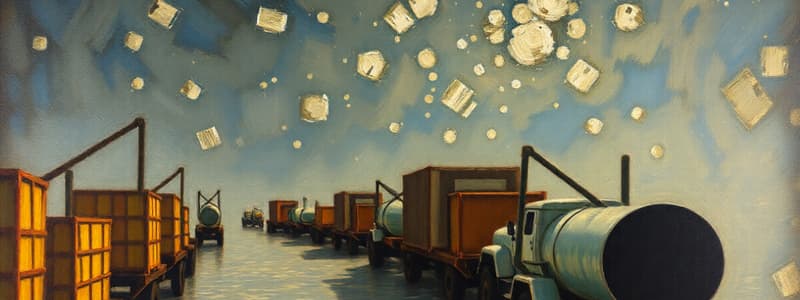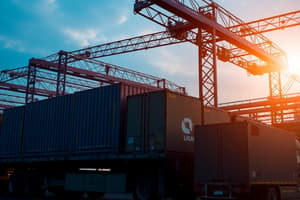Podcast
Questions and Answers
Which of the following is the MOST accurate representation of a supply chain's scope?
Which of the following is the MOST accurate representation of a supply chain's scope?
- It is limited to the transportation and warehousing of goods.
- It solely encompasses the manufacturing processes within a company.
- It focuses on the relationship between the company and its direct suppliers.
- It includes all stages involved, directly or indirectly, in fulfilling a customer request. (correct)
Within a company, what encompasses the supply chain functions related to fulfilling a customer request?
Within a company, what encompasses the supply chain functions related to fulfilling a customer request?
- Only the departments directly involved in production.
- All functions, including product development, marketing, operations, distribution, finance, and customer service. (correct)
- Primarily the logistics and distribution departments.
- The sales and marketing teams, as they interact with the customer.
Which of the following is the MOST critical element for maximizing total supply chain surplus?
Which of the following is the MOST critical element for maximizing total supply chain surplus?
- Minimizing transportation costs.
- Effective management of flows between and among supply chain stages. (correct)
- Optimizing profits at each individual stage of the supply chain.
- Focusing solely on improving customer service levels.
What metric is MOST crucial when evaluating the success of a supply chain?
What metric is MOST crucial when evaluating the success of a supply chain?
What constitutes supply chain surplus?
What constitutes supply chain surplus?
What is the PRIMARY focus of the supply chain strategy or design phase?
What is the PRIMARY focus of the supply chain strategy or design phase?
When defining supply chain planning, which of the following elements is MOST applicable?
When defining supply chain planning, which of the following elements is MOST applicable?
Which decisions fall under the supply chain planning phase?
Which decisions fall under the supply chain planning phase?
What characterizes decisions made during the supply chain operation phase?
What characterizes decisions made during the supply chain operation phase?
Which view considers supply chain processes based on their execution relative to customer demand?
Which view considers supply chain processes based on their execution relative to customer demand?
In the context of the 'cycle view' of a supply chain, at which interface does the 'replenishment cycle' primarily occur?
In the context of the 'cycle view' of a supply chain, at which interface does the 'replenishment cycle' primarily occur?
What is the primary differentiator between 'push' and 'pull' processes in a supply chain?
What is the primary differentiator between 'push' and 'pull' processes in a supply chain?
Where does the push/pull boundary demarcate?
Where does the push/pull boundary demarcate?
Which of the following is NOT one of the three macro processes a supply chain can be classified into?
Which of the following is NOT one of the three macro processes a supply chain can be classified into?
Within the SRM macro process, what activities are generally included?
Within the SRM macro process, what activities are generally included?
Which set of activities falls under Internal Supply Chain Management (ISCM)?
Which set of activities falls under Internal Supply Chain Management (ISCM)?
What activities are typically included in Customer Relationship Management (CRM)?
What activities are typically included in Customer Relationship Management (CRM)?
Considering Dell's supply chain strategy, where would the push/pull boundary be located?
Considering Dell's supply chain strategy, where would the push/pull boundary be located?
How did the choice of Gateway not to carry any finished-product inventory at its retail stores affect its supply chain?
How did the choice of Gateway not to carry any finished-product inventory at its retail stores affect its supply chain?
What advantage does Zara derive from replenishing its stores many times per week, compared to a less frequent schedule?
What advantage does Zara derive from replenishing its stores many times per week, compared to a less frequent schedule?
What factor supports Inditex's decision to maintain manufacturing capacity in Europe, despite cheaper manufacturing costs in Asia?
What factor supports Inditex's decision to maintain manufacturing capacity in Europe, despite cheaper manufacturing costs in Asia?
From local manufacturers, Zara sources products with what type of demand?
From local manufacturers, Zara sources products with what type of demand?
How should markets be allocated to plants?
How should markets be allocated to plants?
What advantages exist for selling books online versus at a traditional store?
What advantages exist for selling books online versus at a traditional store?
Supply chain design decisions are considered what?
Supply chain design decisions are considered what?
What should a good supply chain design do?
What should a good supply chain design do?
What should supply chain profitability do?
What should supply chain profitability do?
What should W.W. Grainger carry at a store?
What should W.W. Grainger carry at a store?
What is the goal when implementing the operating policies of the supply chain?
What is the goal when implementing the operating policies of the supply chain?
What phases encompass Supply Chain Decision?
What phases encompass Supply Chain Decision?
What is fixed from the previous phase of supply chain decisions?
What is fixed from the previous phase of supply chain decisions?
Walmart saw what change in sales due to supply chain decisions?
Walmart saw what change in sales due to supply chain decisions?
How did Dell respond when seeing its position falter?
How did Dell respond when seeing its position falter?
Which of these is an example of a company that effectively employs supply chains?
Which of these is an example of a company that effectively employs supply chains?
Flashcards
Supply Chain
Supply Chain
All stages involved in fulfilling a customer request.
Supply Chain Objective
Supply Chain Objective
Maximize overall value created.
Supply Chain Strategy/Design
Supply Chain Strategy/Design
How to structure the supply chain over the next several years.
Supply Chain Planning
Supply Chain Planning
Signup and view all the flashcards
Supply Chain Operation
Supply Chain Operation
Signup and view all the flashcards
Cycle View
Cycle View
Signup and view all the flashcards
Push/Pull View
Push/Pull View
Signup and view all the flashcards
Pull Processes
Pull Processes
Signup and view all the flashcards
Push Processes
Push Processes
Signup and view all the flashcards
CRM
CRM
Signup and view all the flashcards
ISCM
ISCM
Signup and view all the flashcards
SRM
SRM
Signup and view all the flashcards
Study Notes
Understanding the Supply Chain
- A supply chain includes all stages involved in fulfilling a customer request, directly or indirectly.
- These stages encompass manufacturers, suppliers, transporters, warehouses, retailers, and customers.
- Within each company, the supply chain covers all functions in fulfilling customer requests, such as product development, marketing, operations, distribution, finance, and customer service.
- The customer is an integral part of the supply chain.
- The supply chain involves the movement of products from suppliers to manufacturers to distributors.
- It also includes information, funds, and products moving in both directions.
- The term "supply network" or "supply web" is sometimes more accurate
- Typical supply chain stages include customers, retailers, distributors, manufacturers, and suppliers.
- Not all stages are present in every supply chain, like Dell, which lacks retailers or distributors.
Objective of A Supply Chains
- The goal is to maximize overall value created.
- Supply Chain Surplus = Customer Value – Supply Chain Cost
- For example, a customer buys a wireless router from Best Buy for $60, which is the revenue.
- The costs include information, storage, transportation, components, and assembly.
- The difference between the $60 revenue and the sum of costs shows the supply chain profit.
- Supply chain profitability is the total profit shared across all stages.
- Success is measured by total supply chain profitability, not just profits at one stage.
- The customer is the only source of revenue.
- Costs come from the flows of information, products, and funds between stages.
- Effective supply chain management manages flows between stages to maximize the total supply chain surplus.
Importance of Supply Chain Decisions
- Wal-Mart increased sales from $1 billion in 1980 to $408 billion in 2010.
- Seven-Eleven Japan increased sales from ¥1 billion in 1974 to ¥3 trillion in 2009.
- Webvan folded in two years.
- Borders declined from $4 billion in 2004 to $2.8 billion in 2009.
- Dell, with $56 billion in 2006, adopted new supply chain strategies.
Decision Phases of a Supply Chain
- Supply Chain Strategy/Design: This determines how the supply chain will be structured over years.
- Supply Chain Planning: This involves decisions for the next quarter or year.
- Supply Chain Operation: This covers daily or weekly operational decisions.
Supply Chain Strategy or Design
- Decisions are made about the structure and processes of each stage in the supply chain.
- Strategic decisions include locations and capabilities of facilities, product storage locations, transportation modes, and information systems.
- Supply chain design must support strategic objectives.
- Design decisions are long-term and expensive to reverse, so market uncertainty must be considered.
Supply Chain Planning
- It involves setting policies to govern short-term operations.
- It's fixed by the previous supply configuration.
- Planning starts with a forecast of demand for the upcoming year.
- Decisions include which markets to supply, inventory buildup, subcontracting, inventory policies, and market promotions.
- Demand uncertainty, exchange rates, and competition must be considered.
Supply Chain Operation
- The time horizon is weekly or daily.
- Decisions concern individual customer orders.
- The supply chain configuration is fixed, and operating policies are set.
- The goal is to implement operating policies effectively.
- Tasks include allocating orders, setting due dates, generating pick lists, allocating shipments, setting delivery schedules, and placing replenishment orders.
- There is much less uncertainty.
Process View of a Supply Chain
- Cycle View: The supply chain is divided into cycles, each performed at interfaces between two successive stages.
- Push/Pull View: Processes are divided into categories depending on whether they are executed in response to a customer order (pull) or in anticipation of a customer order (push).
Push/Pull View of Supply Chain Processes
- Processes are categorized based on execution timing relative to customer demand.
- Pull is execution initiated in response to an order (reactive).
- Push is execution initiated in anticipation of orders (speculative).
- The push/pull boundary separates push and pull processes.
- This view is useful for strategic decisions related to supply chain design, providing a global view of how processes relate to customer orders.
- Can combine push/pull and cycle views, such as with L.L. Bean and Dell.
- The proportion of push and pull processes impacts performance.
Supply Chain Macro Processes
- Processes in the two views are classified into:
- Customer Relationship Management (CRM)
- Internal Supply Chain Management (ISCM)
- Supplier Relationship Management (SRM).
- Integration among CRM, ISCM, and SRM is critical for effective supply chain management.
Studying That Suits You
Use AI to generate personalized quizzes and flashcards to suit your learning preferences.



